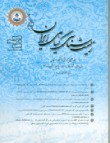The effect of boron and iron deficiency on the contents of photosynthetic pigments, carbohydrates and phenolic compounds in two cultivars of Sorghum bicolor L
Author(s):
Article Type:
Research/Original Article (دارای رتبه معتبر)
Abstract:
In higher plant, boron and iron are two necessary micronutrients and reduce access to those can seriously influence on the vital processes. To study the effect of boron and iron deficiency in sorghum, sterile seeds of two cultivars (Kimia and Sugar-graze) were cultured on modified medium of Murashige and Skoog including lacking H3BO3 or half concentration of iron. Seedlings were harvested after 21 days. Then contents of the photosynthetic pigments, carbohydrates, phenolic compounds and activity of the phenylalanine ammonia lyase (PAL) were measured. The results showed that compared to the controls, contents of the chlorophyll a and b were remarkably increased in Kimia, 58% and 38% by B deficiency and 85% and 75% in Fe deficiency. In treatment of Fe deficiency, carotenoid content significantly increased 8% in Sugar-graze and 80% in Kimia. During boron deficiency, the carotenoid content showed 24% reduction in Sugar-graze and increase of 26% in Kimia cultivar. In the root of Sugar-graze, polysaccharide and reducing sugar contents were increased more than two fold under B deficiency, whereas under Fe deficiency, enhancing of the reducing sugar content was about 58% in the root of Sugar-graze. In the seedling Kimia, under B deficiency, there no significant increase in reducing sugar content was observed and under Fe deficiency only about 25% increase was occurred in the root. Decrease of access to those elements caused to reduce content of the phenolic compounds in root tissue of both cultivars about 20 to 35%, while no significant difference among the aerial parts recorded. In the root of sorghum under deficiency stresses, there was a positive correlation between PAL activity and phenolic content of the plants. Since in sorghum root, decrease in the storage of the phenolic compounds was accompanied by a reduction in PAL activity. It seems that in early growth stages of the sorghum seedling, the increase in the carotenoid and reducing sugar contents and exudation of phenolic compounds from root can be a part of a deal factors against to oxidative stress arising from nutrient deficiency.
Keywords:
Language:
Persian
Published:
Iranian Journal of Plant Biology, Volume:9 Issue: 3, 2018
Pages:
19 to 38
magiran.com/p1791495
دانلود و مطالعه متن این مقاله با یکی از روشهای زیر امکان پذیر است:
اشتراک شخصی
با عضویت و پرداخت آنلاین حق اشتراک یکساله به مبلغ 1,390,000ريال میتوانید 70 عنوان مطلب دانلود کنید!
اشتراک سازمانی
به کتابخانه دانشگاه یا محل کار خود پیشنهاد کنید تا اشتراک سازمانی این پایگاه را برای دسترسی نامحدود همه کاربران به متن مطالب تهیه نمایند!
توجه!
- حق عضویت دریافتی صرف حمایت از نشریات عضو و نگهداری، تکمیل و توسعه مگیران میشود.
- پرداخت حق اشتراک و دانلود مقالات اجازه بازنشر آن در سایر رسانههای چاپی و دیجیتال را به کاربر نمیدهد.
In order to view content subscription is required
Personal subscription
Subscribe magiran.com for 70 € euros via PayPal and download 70 articles during a year.
Organization subscription
Please contact us to subscribe your university or library for unlimited access!


